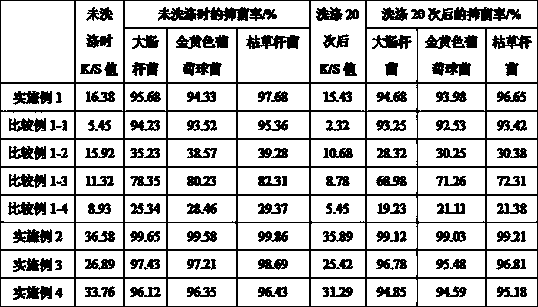Preparation method of indigotic dyeing antibacterial textile
A technology of antibacterial textiles and textiles, applied in the field of textiles, can solve the problems that fibers have no affinity and are not in line with ecological environmental protection, etc., and achieve the effect of increasing the adhesion.
- Summary
- Abstract
- Description
- Claims
- Application Information
AI Technical Summary
Problems solved by technology
Method used
Image
Examples
Embodiment 1
[0021] (1) Prepare a natural indigo dye aqueous solution with a mass fraction of 1%, and then add polyvinylpyrrolidone accounting for 20% of the mass of natural indigo dye. After it is completely dissolved, use a mechanical mixer to stir at a speed of 400r / min for 25min to obtain a pre-dispersion; A titanium alloy ultrasonic probe with a tip diameter of 15 mm was inserted into the pre-dispersion liquid, and ultrasonically dispersed for 20 min at a power of 100 W to obtain a natural indigo dye suspension solution;
[0022] (2) Immerse the desizing, scouring and bleaching pure cotton fabric in the natural indigo dye suspension solution, roll it after 30 seconds, double dipping and two rolling, the excess rate is 80%, and dry at 60°C for 10 minutes. Padding the copper acetate aqueous solution with a mass concentration of 8g / L, two dipping and two rolling, the excess rate is 80%, vacuum drying at 60°C, and ready for use;
[0023] (3) In an autoclave with polytetrafluoroethylene, p...
Embodiment 2
[0041] (1) Prepare a natural indigo dye aqueous solution with a mass fraction of 5%, and then add polyvinylpyrrolidone accounting for 30% of the mass of natural indigo dye. After it is completely dissolved, use a mechanical mixer to stir at a speed of 600r / min for 15 minutes to obtain a pre-dispersion; A titanium alloy ultrasonic probe with a tip diameter of 15 mm was inserted into the pre-dispersion liquid, and ultrasonically dispersed for 10 min at a power of 200 W to obtain a natural indigo dye suspension solution;
[0042] (2) Immerse the desizing, scouring and bleaching hemp fabric into the natural indigo dye suspension solution, roll it after 30 seconds, double dipping and two rolling, the excess rate is 100%, dry at 80°C for 5 minutes, dip Roll the copper sulfate aqueous solution with a mass concentration of 16g / L, two dips and two rolls, the excess rate is 100%, vacuum dry at 80°C, and set aside;
[0043] (3) In an autoclave with polytetrafluoroethylene, prepare a mixe...
Embodiment 3
[0045] (1) Prepare a natural indigo dye aqueous solution with a mass fraction of 2.5%, and then add polyvinylpyrrolidone accounting for 25% of the mass of natural indigo dye. After it is completely dissolved, use a mechanical mixer to stir at a speed of 500r / min for 20min to obtain a pre-dispersion; A titanium alloy ultrasonic probe with a tip diameter of 15 mm was inserted into the pre-dispersion liquid, and ultrasonically dispersed for 15 min at a power of 150 W to obtain a natural indigo dye suspension solution;
[0046] (2) Immerse the viscose fabric that has been desized, scoured and bleached into the natural indigo dye suspension solution, and roll it after 30 seconds, double dipping and two rolling, the excess rate is 90%, and after drying at 70°C for 8 minutes, Padding the copper nitrate aqueous solution with a mass concentration of 12g / L, two dips and two rollings, the excess rate is 90%, vacuum drying at 70°C, and ready for use;
[0047] (3) In an autoclave with poly...
PUM
 Login to View More
Login to View More Abstract
Description
Claims
Application Information
 Login to View More
Login to View More - R&D
- Intellectual Property
- Life Sciences
- Materials
- Tech Scout
- Unparalleled Data Quality
- Higher Quality Content
- 60% Fewer Hallucinations
Browse by: Latest US Patents, China's latest patents, Technical Efficacy Thesaurus, Application Domain, Technology Topic, Popular Technical Reports.
© 2025 PatSnap. All rights reserved.Legal|Privacy policy|Modern Slavery Act Transparency Statement|Sitemap|About US| Contact US: help@patsnap.com

